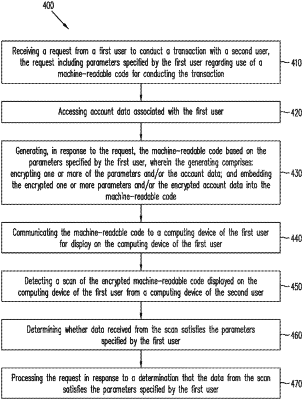| CPC G06Q 20/3276 (2013.01) [G06K 7/1417 (2013.01); G06K 19/06037 (2013.01); G06Q 20/383 (2013.01); G06Q 50/01 (2013.01)] | 20 Claims |

|
1. A system, comprising:
a non-transitory memory; and
one or more hardware processors coupled to the non-transitory memory and configured to read instructions from the non-transitory memory to cause the system to perform operations comprising:
receiving, by an application operating on the system, a request from a first user account to conduct a transaction with a second user account, the application having a user interface that displays a first option that enables the transaction to be conducted with non-genericized user data and a second option that enables the transaction to be conducted with genericized user data, wherein the request includes a selection of the second option;
generating, by the application in response to the received request, an encrypted machine-readable code based on a set of parameters specified by the first user account and based on the selection of the second option;
embedding an error-detection mechanism in the machine-readable code, wherein the error-detection mechanism is extractable from the machine-readable code upon being scanned;
transmitting, by the application, the encrypted machine-readable code to a service provider; and
providing the encrypted machine-readable code for display on a device associated with a second user account, wherein the encrypted machine-readable code, when scanned and provided to the service provider by the device associated with the second user account, is usable by the service provider to execute the transaction while genericizing the first user account on an electronic platform, and wherein the transaction is suspendable in response to the error-detection mechanism indicating a corruption or tampering of data in the machine-readable code.
|